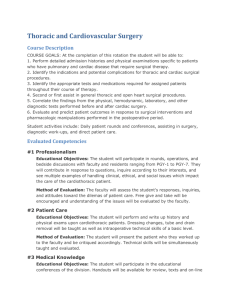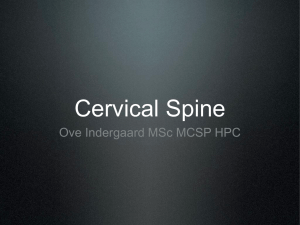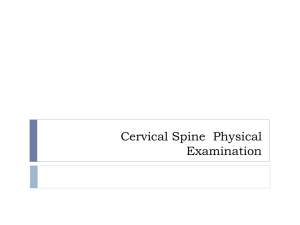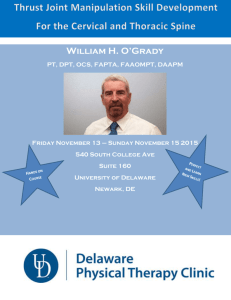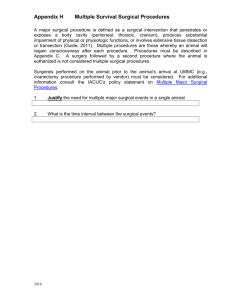INDUSTRY SPONSORED PROJECTS I1
advertisement
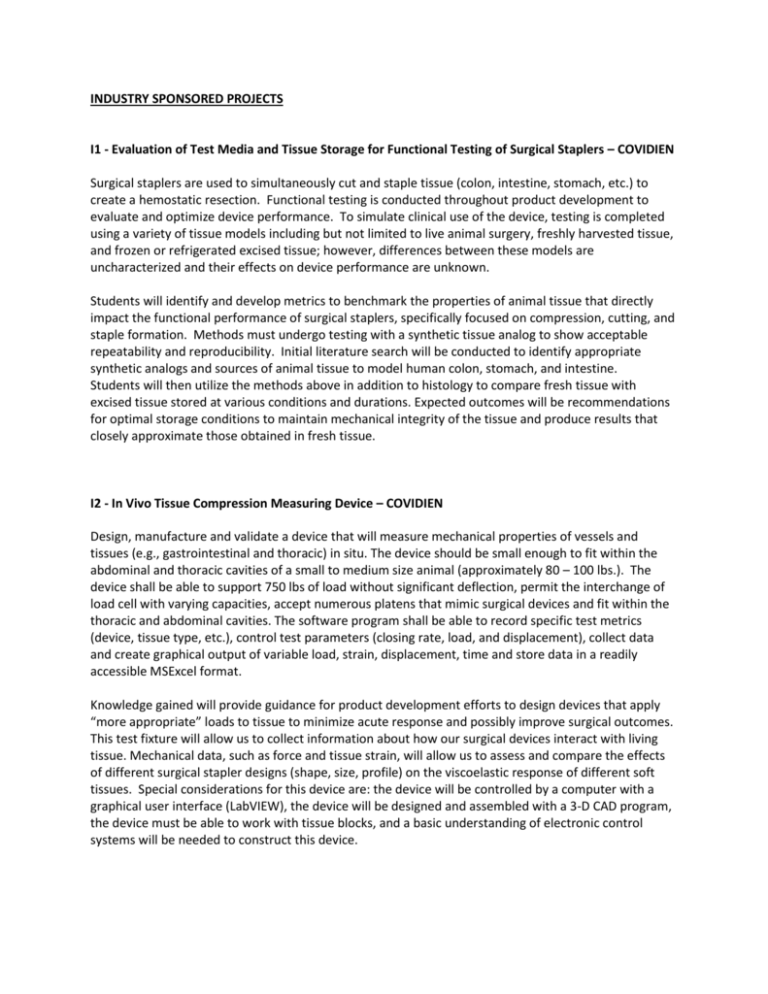
INDUSTRY SPONSORED PROJECTS I1 - Evaluation of Test Media and Tissue Storage for Functional Testing of Surgical Staplers – COVIDIEN Surgical staplers are used to simultaneously cut and staple tissue (colon, intestine, stomach, etc.) to create a hemostatic resection. Functional testing is conducted throughout product development to evaluate and optimize device performance. To simulate clinical use of the device, testing is completed using a variety of tissue models including but not limited to live animal surgery, freshly harvested tissue, and frozen or refrigerated excised tissue; however, differences between these models are uncharacterized and their effects on device performance are unknown. Students will identify and develop metrics to benchmark the properties of animal tissue that directly impact the functional performance of surgical staplers, specifically focused on compression, cutting, and staple formation. Methods must undergo testing with a synthetic tissue analog to show acceptable repeatability and reproducibility. Initial literature search will be conducted to identify appropriate synthetic analogs and sources of animal tissue to model human colon, stomach, and intestine. Students will then utilize the methods above in addition to histology to compare fresh tissue with excised tissue stored at various conditions and durations. Expected outcomes will be recommendations for optimal storage conditions to maintain mechanical integrity of the tissue and produce results that closely approximate those obtained in fresh tissue. I2 - In Vivo Tissue Compression Measuring Device – COVIDIEN Design, manufacture and validate a device that will measure mechanical properties of vessels and tissues (e.g., gastrointestinal and thoracic) in situ. The device should be small enough to fit within the abdominal and thoracic cavities of a small to medium size animal (approximately 80 – 100 lbs.). The device shall be able to support 750 lbs of load without significant deflection, permit the interchange of load cell with varying capacities, accept numerous platens that mimic surgical devices and fit within the thoracic and abdominal cavities. The software program shall be able to record specific test metrics (device, tissue type, etc.), control test parameters (closing rate, load, and displacement), collect data and create graphical output of variable load, strain, displacement, time and store data in a readily accessible MSExcel format. Knowledge gained will provide guidance for product development efforts to design devices that apply “more appropriate” loads to tissue to minimize acute response and possibly improve surgical outcomes. This test fixture will allow us to collect information about how our surgical devices interact with living tissue. Mechanical data, such as force and tissue strain, will allow us to assess and compare the effects of different surgical stapler designs (shape, size, profile) on the viscoelastic response of different soft tissues. Special considerations for this device are: the device will be controlled by a computer with a graphical user interface (LabVIEW), the device will be designed and assembled with a 3-D CAD program, the device must be able to work with tissue blocks, and a basic understanding of electronic control systems will be needed to construct this device. I3 - Circular Stapler User Compression Determination Device (CSUCDD) – COVIDIEN A system is needed that will consist of a measurement device that will gauge that amount of force applied to the tissue via a circular stapler (PPCEEA, CEEA, DST EEA). The device will allow for user to compress synthetic and explanted tissues and LabVIEW should be used so that this device will record, store, and export data such as; force, rate, and distance of staple anvil in relation to staple cartridge. The device will be used for benchmarking current staple compressions with manual devices to help develop future algorithms for advanced surgical devices. I4 - Automated Pick Counter for Braided Suture – TELEFLEX MEDICAL Teleflex Medical in Coventry, CT is a medical device company that manufactures polymers, fibers, monofilament and braided suture. As part of the suture inspection process, picks per inch (PPI) is one of the critical parameters on our braided suture which needs to meet our customer specification. A pick is one repeat of the braid measured along the braid axis. This is the location on a braided suture where one thread crosses over another thread. Our current measurement system includes manual counting system where an operator counts the picks under magnified scope. The goal of this project is to develop an automatic imaging system for calculating braid pick counts and braid angles. We would have the students design a system, build it with parts/fixtures/software/optics, evaluate various braids and write procedure for its use. The students are expected to use their knowledge base from bioinstrumentation and bioinformatics (programming) with assistance of faculty in these respective fields. I5 - Spinal Interbody Fusion Graft Delivery Devices – SPINE WAVE (Dr. Gielo-Perczak, faculty advisor) Interbody spinal fusion surgery involves placing a mechanical spacer between the vertebral bodies to induce boney fusion of the motion segment. Graft material is then introduced to promote bone growth. This graft material may be chips of the patient’s bone, donor bone from another source, or synthetic material. Spine Wave currently has a graft gun under development and requires a loading method for these materials into a tube to facilitate use in the surgical suite as an intermediate deliverable (proposed to be delivered prior to the semester break). The second phase of this project is the development of a novel funnel system that utilizes flowing saline to facilitate delivery of the graft material to the fusion site. I6 - Design Calibration Device for Force Platforms – AMTI (Dr. Gielo-Perczak, faculty advisor) Six component (Fx, Fy, Fz, Mx, My, Mz) force plates are widely used in the biomechanics field to measure the ground reaction forces of a subject during various activities. The data from the force plates is non-invasive and has many uses. One simple example is the stability determination of a subject standing on a force plate. The center of pressure of that subject is readily calculated using the forces and moments channels. In cases of neurological effects (like intoxication, drug induced impairment or sensory deficits), the stability outputs are quite different. Another example, which requires more mathematical effort, is the computation of the joint reaction forces on particular joints of the body like the knee. This is usually done in conjunction with a motion capture system. In all cases, force plates are never perfect and the data output from them has errors. There is crosstalk, hysteresis, noise, nonlinearity, and manufacturer claim that may not be true. The errors and their effect on the usefulness of the data need to be determined. A quantification of the effect of errors is needed. Appropriate test methods need to be developed. Human subjects are generally not exactly repeatable in their force plate outputs. With the combination of a motion capture system, mechanical systems could be envisioned that would reproducibly determine system accuracies. Testing of three different manufacturer’s force plates under a variety of mounting and computational conditions is needed. Human subjects and some custom design testing approaches would be used. One goal of this project is to compare direct force measurements from force platforms with force estimations based on the equations of motion of an inverted pendulum-like system. Specific goals for this project are: Design the cylinder and rod to fulfill the study’s needs, Calculate reaction forces and moments from the equation of motions, Record forces and moments from three different force platforms, Compare the two mode of forces recordings (sensitivity, accuracy, crosstalk), Compare the different force plates technology (sensitivity, accuracy, crosstalk), and Collect some basic walking data and analyze the effect of force and moment inaccuracy on internal knee loads and moments. I7 - Treadmill Control System – Providence Veteran Medical Administration Center (Dr. Gielo-Perczak, faculty advisor) The focus of this project will be to control the split belt treadmill to deliver varying perturbations to the right and left feet independently. Actuators the ends of both of either track provide the capability of raising, lowering or reclining the tracks. Speeds can be offset to simulate walking or running around a curve. A schematic of the control set up can be seen in Figure 2. The overall goal of this project is to use MatLab, LabVIEW or Visual Basic to communicate with the control system of the actuators and move the treadmill in a predictable manner. The motion of the treadmill will need to be integrated with the visual display. Along with the control of the actuators, it will be necessary for students to understand how humans walk, go up and down ramps, use stairs and go around curves so the motions of the treadmill feel realistic to the user. This project will require a good understanding of computer programming and involve use of motion capture data to match treadmill motion with normal human walking patterns. I8 - Visual Display System – Providence Veteran Medical Administration Center (Dr. Gielo-Perczak, faculty advisor) The focus of this project will be to development of the virtual world in which the treadmill will be used. Combined with virtual reality technology, the user can be immersed into an environment and presented with challenges ranging from walking down a path to stair climbing or hiking. It is believed that VR technology can enhance the rehabilitation of patients with gait disabilities. Vizard Virtual Reality software will be used to build complete, interactive 3D content (See Figure 3). Vizard abstracts the field of 3D computer graphics and places it in your hands through a simple scripting language called Python and it enables you to build 3D worlds very quickly. The Vizard software will be used with Live Characters so that an avatar of the treadmill user will be presented in the visual display. Student will need to become familiar with the Vizard software, learn how to build 3D VR environments and work with Live Characters. They will also need to become familiar with motion capture techniques, which are critical to the implementation of an avatar. The visual system will need to be integrated with the control system of the treadmill. Engineering World Health Projects Legacy Projects: H1 - Sterilizer tester: For medical instruments to achieve sterility, autoclaves commonly use steam heated to 121-134 C (250273 F). Unwrapped instruments require a holding time of 15-20 minutes at 121 C (250 F) and instruments packed in layers of cloth require additional time. Flash sterilizing is usually done at a higher temperature, typically 134 C (273 F) for 3 minutes. To ensure that a sterilizer is thoroughly sterilizing its contents, the technician needs to know that the specific minimum threshold temperature was reached and for how long it was maintained during a particular sterilization cycle. Classic sterilizer testing techniques (such as Bowie-Dick test cards) are disposable and can, in addition to being too expensive, be very hard to find in resource poor settings. We are looking for a team that can design a reusable, reliable but low cost means of testing steam sterilizers. Over time, excessive heat can damage the items being sterilized so, as a bonus, the device would also measure the actual temperature reached inside the chamber as well as how long that temperature has been maintained. H2 - Long-lifetime negatoscope (view box): Negatoscopes are used to observe and examine x-ray photographs. They are very useful in clinical settings but also serve as an essential part of any mobile x-ray exam. Many older system’s existing designs use fluorescent lamps that tend to break down, and appropriate replacement lamps are hard to find in resource-poor settings. Thus, we would like to determine if a long-lifetime negatoscope is feasible and develop it. A long-lifetime negatoscope would have a lifespan of 30,000 hours or more. Such a design would preferably be more power-efficient than current designs, hopefully reaching 60 lumens per Watt. This is a challenging project, as negatoscopes require an evenly lighted field of adequate dimensions. The brightness of the field must be considerable but not so great as to cause blinding, while the chromaticity must be close to that of daylight. LED versions of this equipment are now available in volume at $80 retail. Beating this price significantly or allowing for the design to be manufactured in a developing nation would be an important goal. H3 - O2 analyzer A team of EWH design students has developed a proof of concept for an electronic O2 tester that will determine if an oxygen concentrator is indeed producing concentrated oxygen. Often there is no way to test for this in the developing world clinical setting, and the zeolite crystals used to create concentrated oxygen in these devices deteriorate over time. The proof of concept design used two zinc-air batteries in a simple electric circuit with an LED for indication. More design work needs to be done to develop a physical case that will interface with oxygen concentrator tubing and protect the batteries from overexposure to air when they are not in use. More testing is also necessary to determine the functional range of the tester and the characteristics of the circuit with exposure to different oxygen concentrations over different time periods. Modifications might also be made to the circuit, or a different approach could be implemented. Non-Legacy Projects H4 - Inexpensive multi-parameter tester: Hospital equipment technicians (BMETs) have a frequent need to measure temperatures, pressures, and flow rates of both liquids and gasses. Commercial devices can cost over $2000 and are out of the budget range of developing world technicians. This project would seek to develop transducers which could be manufactured locally in the developing world and function on an open source computer platform of extremely low costs ($45 to $75). Any team working on this research project would have to provide at least the design of low cost transducers and a method of calibration for each transducer which does not depend on an expensive metrology laboratory and national standards. The team would have to provide the means and methods description for manufacturing and calibration in a low technology manufacturing setting. Projects capable of measuring only one or two of the suggested parameters (temperature, pressure, or flow rate) will also be accepted. H5 - Solar sterilization and distillation unit for water: Using a multitude of mirrors and a pressure cooker, design a sterilization unit. Such a unit will have a dual purpose. The first will be to autoclave and sterilize surgical equipment. Temperature monitoring within the unit will ensure that appropriate temperatures are reached. A weight on the pressure cooker valve will ensure that appropriate pressures are reached, even when the atmospheric pressure is above sea-level. A second pressure cooker, without its valve can be used to generate steam that can be condensed in order to generate potable water. An inexpensive heat exchanger will allow the latent heat of steam (during condensation) to preheat the water. H6 - Portable, inexpensive oxygen concentrator: Oxygen concentrators use a material such as Zeolite to adsorb nitrogen. The goal of this project is to come up with cheap alternatives with reusable air filters. The concentrator should provide means to humidify the oxygen using distilled water prior to delivering to a patient. H7 - Stand-alone surgical lamp: A device which will use LEDs, Supercapacitors/Batteries (during power failures) Note: the initial cost of this device may be relatively expensive. Surgical lamps are often unavailable in developing countries and are expensive as bulbs need to be replaced. Power failures are common in these countries. Battery operated lamps have batteries with toxic materials. Today the price of supercapacitors is down to 2.5 cents/farad and these last for hundreds of thousands of charge/discharge cycles and are green. LEDs are at least 5 times as efficient as incandescent lamps. A 10 watt array of LEDs equates in luminance to a 50 Watt conventional bulb. For example, a 5V 1500 Farad stack can store as much as 15000 usable Joules. This would allow the operating field to have over 24 minutes of usable light at 10 Watts (LED). An inexpensive lens will allow the light to be focused onto the surgical field. The supercapacitors may be charged using PV cells or inexpensive batteries and be ready to use during surgery. A battery stack could also be used to charge the supercapacitors and operate in parallel. Evaluate charging these capacitors using a pedal powered generator. H8 - Apparatus for evaluating hearing loss: Audiometers are expensive and require a quiet room to conduct the tests. Using an inexpensive processor such as the Raspberry Pi, create an audiometer with conventional headphones. The frequency response of these can be calibrated using an inexpensive (calibrated) microphone. Sound is generated into the headphones. Using 3D printing or inexpensive methods, build a wrapper around the headphones in order to suppress ambient noise during the test. Alternatively, use the calibrated microphone to detect ambient noise and vary the sound levels appropriately into the headphones. H9 - Inexpensive patient-bedside communication system: Using an inexpensive processor, such as the Raspberry Pi and Wi-Fi module, create a VOIP system that allows two-way communications between a patient and the nurse in an ICU. This system can also be used in a small clinic to communicate between departments. H10 - Inexpensive LED-based otoscope: Using multiple colored LEDs and inexpensive lenses create an otoscope for examination of ear infections using various color combinations. H11 - NI myDAQ Fetal Doppler Phantom The myDAQ from National Instruments is a measurement and instrumentation device designed especially for students. It has digital and analog I/O ports and there are many transducer and other plugs-ins for myDAQ. Fetal Doppler units are available in the developing world, and there tend to be plenty of broken devices. The goal of this project would be to create an inexpensive (potentially electromechanical) phantom which could be used as a signal source for Fetal Doppler repair by developing world BMETs. H12 - Smart Phone Based Toco Transducer and tocodynamometer The tocodynamometer is a component of external monitoring in childbirth. The goal of this project is to use a smart phone with a built-in accelerometer and a software application to act as a toco transducer and recording tocodynamometer. The device would be used to record the duration of uterine contractions and the duration between them. H13 - Inexpensive tester for plantar (foot) neuropathy: Testing for nerve damage is done today with various filaments and training. Invent a device with variable tensions in order to test and quantify various stages of neuropathy. One embodiment may use springs. The device may be 3D printed and cleaned by isopropyl alcohol. The patient could rest his or her foot onto this device. Different forces may be applied using mechanical means to determine the extent of Neuropathy. Other approaches might also be considered. PROJECTS SPONSORED BY CLINICAL PARTNERS C1 - Contributions of Thoracic Motion to Cervical and Shoulder Range of Motion in Patients Suffering from Cervical or Shoulder Pain Symptoms – PHYSICAL THERAPIST AT UCONN HEALTH CENTER Pain with cervical rotation may be caused by limitations of motion at the thoracic spine as end range cervical rotation can cause movement down to the forth thoracic vertebrae. Researchers have found that reduced mobility at the cervicothoracic junction was a risk factor for neck pain and that highvelocity, low-amplitude thrust manipulations (HVLATM) of the thoracic spine has been shown to decrease pain and increase cervical motion in individuals suffering from cervical pain and limitation. However, this is not validated this concept and the ability to directly assess and determine the contributions of thoracic spine motion to cervical pain remains difficult. Special clinical tests that use this concept have yet to be assessed for reliability and validity in the clinical evaluation of the thoracic spine in patient that suffer from cervical pain and motion limitations. A measurement device is needed that is able to accurately measure thoracic spine motion and how this motion relates to the range of motion of the cervical spine and shoulder in order to help determine the contributions of the thoracic spine to these motions and help to validate the theoretical constructs involved in treating the thoracic spine in patients suffering from cervical and shoulder pain. C2 - Development of a Portable Bilirubin Meter as a Smart Phone Application – NEONATOLOGIST AT CONNECTICUT CHILDREN’S MEDICAL CENTER Newborn babies often are jaundiced; however, high levels of the chemical causing the jaundice may inure the developing brain. These injuries include hearing disorders, cerebral palsy, movement disorders and speech problems. Currently blood testing is widely used, which is painful and has inherent risks. In many hospitals there are commercially-available non-invasive photometers. A smart phone app would make testing at home more simple and improve the ability to protect a vulnerable infant. C3 - Development of an Electronic Stethoscope for the Continuous Detection of Bowel Sounds (Part II) – NEONATOLOGIST AT CONNECTICUT CHILDREN’S MEDICAL CENTER A Neonatal Intensive Care Unit (NICU) provides care for infants in constant need of supervision. Currently, respiration, heartbeat, blood pressure, and oxygen saturation are displayed on a bedside monitor. There is a need to develop a continuous monitoring of bowel sounds as another vital sign, in order to assess intestinal health and to titrate feedings. There are currently no bowel sound recorders or analyzers in NICUs and normal values are not available for premature babies at differing gestational and postnatal ages. Yet, newborn babies frequently have feeding disorders, some which are quite serious. The goal is to develop a sensor to be attached to the infant’s abdomen along with a monitoring system for signal reception, filtration, analysis, and display. The anticipated result is promoting better feedings and to also avoid dangerous life threatening illnesses that threatens newly born infants. Current design barriers have been centered around the attachment of the sensor and the complex processing of the biosignal, where the elimination of unwanted noise and better signal processing are desired. Note that this is a continuation of a previous Senior Design Project from 2012-13 academic year. PROJECTS PROPOSED BY BME FACULTY F1 - Tomography Illumination Add-On for 3D Microscopy Imaging – Dr. Guoan Zheng Conventional optical microscope can only perform 2D imaging of the biological samples. In this project, we will design and implement a cost-effective tomography illumination module to achieve 3D imaging capability. Using this cost-effective module, we will turn every 2D microscope into a 3D microscope without any optical modification. F2 - Design and Construction of Illumination Add-On for Differential-Interference-Contrast Microscopy – Dr. Guoan Zheng An optical microscopy image contains 2 major types of image information: light amplitude and optical phase spatial distribution. Amplitude image information is readily extractable as optical detectors, ranging from our retina layers to a CCD camera, are sensitive to light intensity – the square of the light amplitude. Unlike light amplitude distribution, the optical phase distribution associated with a microscope image is more difficult to extract. In the biomedicine setting, differential-interferencecontrast (DIC) microscopy dominates in many applications. In this project, we will design and implement an illumination add-on module for DIC microscopy imaging. Using this cost-effective module, we will turn every microscope into a DIC-enabled microscope without any optical modification. F3 - Cost-Effective 400 Megapixel Microscope System – Dr. Guoan Zheng Fourier ptychographic microscopy (FPM) is a recently developed imaging modality that uses a low-cost LED array and a conventional microscope to perform billion-pixel imaging. In this project, we will design and implement a low-cost FPM system for resource-limit environments (potentially useful for global health problems such as malaria diagnosis). The cost of platform is about 20% of a conventional microscope while the final reconstructed image contains about 400 megapixels, two orders of magnitude more pixels than the conventional high-end microscopes. F4 - “On-chip” Real-Time Polymerase Chain Reaction Using a Microcontroller – Dr. Guoan Zheng The polymerase chain reaction (PCR) is a scientific technique in molecular biology to amplify a single or a few copies of a piece of DNA across several orders of magnitude, generating thousands to millions of copies of a particular DNA sequence. The method relies on thermal cycling, consisting of cycles of repeated heating and cooling of the reaction for DNA melting and enzymatic replication of the DNA. In this project, we will design and implement PCR device that consists of three different subsystems: heating, cooling, and sensing. We will also perform epifluorescence detection to validate the device. F5 - Design and Implement of Rapid Anal Canal Scanner – Dr. Guoan Zheng The incidence rate of squamous cell carcinoma of the anal canal (SCCA), one of the HPV-related malignancies, has doubled in the last two decades. State of the art optical imaging technology has the capacity to greatly improve on the current system by reducing high resolution anoscopy screening to a process utilizing technology closely related to handheld document scanners. In this project, we will design, implement and validate a systematic scanner system that is able to rapidly acquire a complete surface image of the anal canal. The design will be based on a cost-effective document scanner and a rotational actuation system that pivot the scanner for a 360 degree scan.
